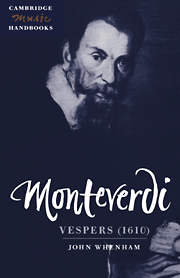Book contents
- Frontmatter
- Contents
- Acknowledgements
- List of abbreviations
- 1 Introduction
- 2 The 1610 settings and the liturgy of Vespers
- 3 The 1610 print and Monteverdi's career
- 4 ‘Suited to the chapels or chambers of princes’
- 5 ‘And all on a cantus firmus’
- 6 Issues of performance
- Appendices
- Notes
- Select bibliography
- Discography
- Index
2 - The 1610 settings and the liturgy of Vespers
Published online by Cambridge University Press: 12 January 2010
- Frontmatter
- Contents
- Acknowledgements
- List of abbreviations
- 1 Introduction
- 2 The 1610 settings and the liturgy of Vespers
- 3 The 1610 print and Monteverdi's career
- 4 ‘Suited to the chapels or chambers of princes’
- 5 ‘And all on a cantus firmus’
- 6 Issues of performance
- Appendices
- Notes
- Select bibliography
- Discography
- Index
Summary
Monteverdi's 1610 publication contains music for Mass and Vespers, the two services of the Roman Catholic liturgy that were most frequently supplied with elaborate musical settings in late sixteenth- and early seventeenth-century Italy. The Mass remains a central feature of the modern liturgy, though not in the form approved by the Council of Trent (the ‘Tridentine’ form) that Monteverdi would have known. The service of Vespers is, perhaps, less familiar, but some knowledge of its liturgy – that is, of the texts appointed by the Church to be said or sung at a Vespers service – is necessary not only for understanding why Monteverdi set the particular group of texts that he did, but also when evaluating various arguments about the contents of the 1610 print: arguments that have influenced both editions and performances of the music. And knowing how the psalms and Magnificat were customarily chanted in plainsong at Vespers is a valuable preliminary to analysing Monteverdi's settings, which make play with the ways in which his contemporaries would have expected to hear psalms sung in church. The first part of this chapter, then, provides a brief outline of Vespers, and Examples 1 and 2, below, can be used as a practical introduction to singing psalms in plainsong and falsobordone in conjunction with Appendix 2, which gives the texts and plainsongs of the psalms set by Monteverdi, using the same notational conventions.
- Type
- Chapter
- Information
- Monteverdi: Vespers (1610) , pp. 6 - 22Publisher: Cambridge University PressPrint publication year: 1997



